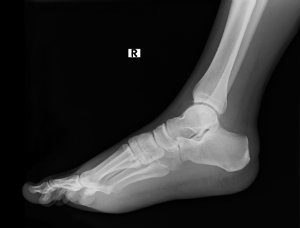


Nobody is ever looking for fractures to happen, but all they take is one unfortunate moment. A slip, a fall, a crash, a bad tackle—you almost never see it coming, but you’ll be feeling the results for some time. Each human foot contains 26 bones, and put together the feet comprise nearly one-quarter of the bones in the body. When one or more bones in the feet or ankles become broken, your best option for treatment lies with a specialist in that area.
 Fractures, Piece by Piece
Fractures, Piece by PieceNot every fracture is the same. There are different general types that will require different approaches of treatment depending upon their location and severity.
The first thought most people have of fractures is a break extended fully through the bone. Of these types, some will just break apart and not shift in any way. If pieces of the broken bone do move out of alignment, they are considered displaced.
A bone can also sustain cracks along its surface, known as stress fractures. These often are the result of repetition and overuse, but can grow deeper if not addressed.
Toe and Forefoot Fractures – Broken bones in this section of the foot can involve the phalanges (“toe bones”) or metatarsals (the long bones that connect the toes to the rest of the foot. The fifth metatarsal, beneath the little toe, has a tendency to suffer specific forms of breaks. A sharp twist of the ankle can tear a piece of the bone from the rest, and a fracture at the base of the bone—known as a Jones fracture—can disrupt the blood supply and require more specialized attention.
Midfoot Fractures – A broken bone in the midfoot, sometimes referred to as a Lisfranc injury, can be easy to misdiagnose as a sprain. They can result from a simple fall or high-force trauma, and be considerably damaging to surrounding tissues if not addressed.
Heel Fractures – A broken heel usually requires a significant amount of force, such as a car crash or a fall from a significant height. In severe cases, there can be a significant risk of the heel becoming deformed or long-lasting consequences such as arthritis and chronic pain.
Ankle Fractures – Ankle fractures can be varied. A broken bone in the ankle does not necessarily mean you won’t be able to walk on it (although you should never try to walk on a suspected fracture of any type as much as possible). The ligaments surrounding the ankle joint might also become involved in the damage.
When a fracture is suspected, it is important to seek medical treatment as soon as possible. In the meantime, keep all weight off the affected area and gently apply ice for up to 20 minutes at a time to reduce swelling. If you have to wear a shoe, make it wide and with a stiff sole for support.
In some cases, such as a minor broken toe, the injured area may be taped to its neighbor for support until it naturally heels. In more complicated cases, a cast may need to be worn for several weeks to several months to allow the bones a chance to heal properly. Once the cast is off, physical therapy and exercises will likely be recommended to condition the area back to full strength.
In severe cases, surgery may be needed to repair the bones and surrounding soft tissues. The type of procedure needed will depend upon the nature of the injury, but we take care to discuss and fully explain the options to our patients.
A fracture may be sudden, but treatment for one needs to be well planned and consistent. Dr. Kevin Powers of Bloomington, IN will treat your fracture with the utmost care and work with you throughout the recovery process. Contact our office by calling (812) 333-4422.